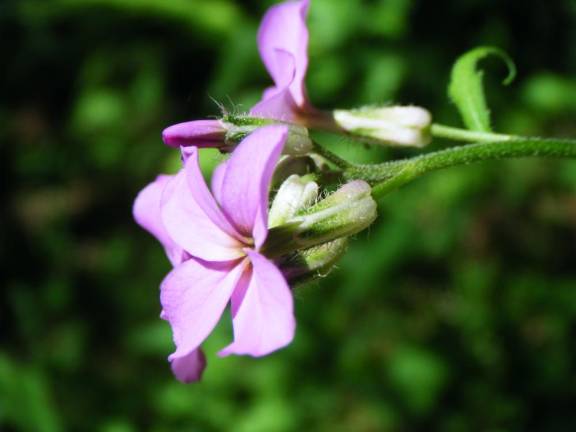Beauty and a touch of bitter



Spring heralds the return of so many precious wild edibles, among them one mighty special dame: dame’s rocket. A native to Europe, dame’s rocket has long been valued as an ornamental, included in wildflower mixes and planted in gardens, but she’s so much more than a pretty face.
Dame’s rocket derives its scientific name, Hesperis matronalis, from the Greek words hespers, meaning “evening,” and matronalis meaning “of a married woman.” Also sometimes called mother-of-the-evening, the plant’s flowers produce their strongest aroma at nightfall. But despite her aesthetic appeal, this dame is non-native and invasive, and considered noxious in New York state. Thus, a perfect plant for our plates.
Like many members of the mustard family to which dame’s rocket belongs, its leaves are both spicy and bitter, making them an excellent addition, in moderation, to hot or cold salads, sandwiches, sautés and soups. The flavor is so similar to that of arugula – also called rocket – that it’s likely how the plant earned its common name. Arranged alternately on a tall stalk, leaves are lance-shaped and minutely toothed. Before the plant has flowered, leaves are less bitter, and those small leaves that clasp near the top of the stalk are the most tender. Enjoy leaves raw or cooked and know that a touch of bitter is beneficial for digestion.
The flowers of dame’s rocket are edible too, and provide a beautiful addition to wild green salads or open-faced sandwiches from late spring through early summer. Flowers may be white, pink or light purple and are borne in clusters terminally on long stalks that arise from leaf axils. Each flower is three-quarters of an inch wide and four-petaled. Be mindful not to confuse dame’s rocket with phlox, which bears five-petaled flowers and opposite leaves. Flowers gradually give way to long slender green siliques lined with tiny seeds. Seeds are spicy like mustard. Slice a silique lengthwise to meticulously harvest seeds for use in dressings or sauces or just use silique and all, adding them whole to soups or dicing and blending with bland foods like potatoes or pasta for spice.
Keep an eye out for this fine lady along shaded embankments, streamside, and in dappled sun bordering woods. She’s sure to catch your eye.